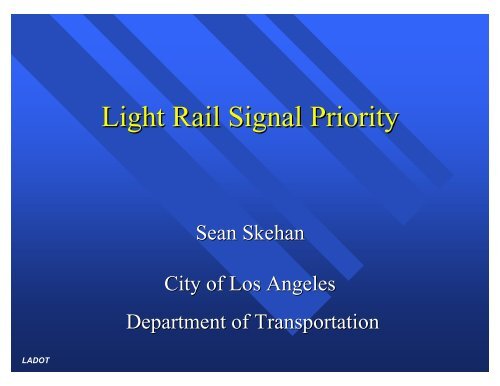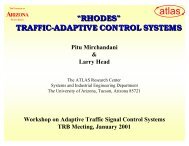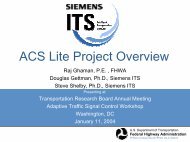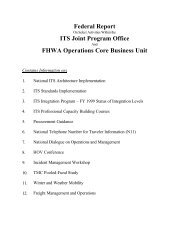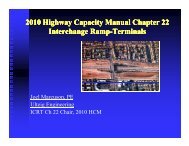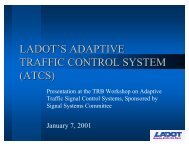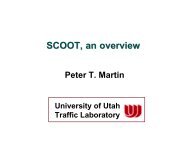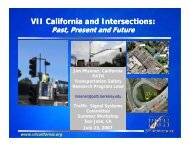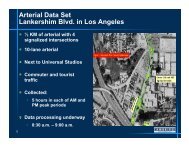LRT Priority - Traffic Signal Systems Committee
LRT Priority - Traffic Signal Systems Committee
LRT Priority - Traffic Signal Systems Committee
You also want an ePaper? Increase the reach of your titles
YUMPU automatically turns print PDFs into web optimized ePapers that Google loves.
Light Rail <strong>Signal</strong> <strong>Priority</strong>Sean SkehanCity of Los AngelesDepartment of TransportationLADOT
Metro Blue Line■ Opened in June 1990■ Five miles of street running■ Center median operationLADOT
<strong>Signal</strong> Network■ UTCS once-per-second control■ Semi-actuated coordinated operation■ Protected-only left turn phasing■ Separate signal indications for trainsLADOT
<strong>LRT</strong> Detection■ Two small loops placed between the tracks■ Advance detector just past upstream signal■ Release detector at limit lineLADOT
<strong>LRT</strong> <strong>Signal</strong> Indications■ Permissive indication shown only when an<strong>LRT</strong> is detected at the intersection■ <strong>LRT</strong> phases are operated concurrently withthrough traffic■ Dwell operation used in short-block areas tominimize slowing between intersectionsLADOT
<strong>LRT</strong> <strong>Priority</strong> Operation■ Early green - <strong>LRT</strong> phase is started earlierthan normal to minimize delays to stoppedor approaching trains■ Green extension - <strong>LRT</strong> phase is held pastnormal endpoint to help slower trains passthrough critical intersectionsLADOT
Early Green■ Used only for trains entering a group ofsimultaneous signals■ Helps get trains moving so they have thebest chance possible to pass through theentire group of signals■ Reduces stopped delay when trains areahead of the progression bandLADOT
Green Extension■ Used only for trains exiting a group ofsimultaneous signals■ Helps give slower trains a better chance atpassing through the entire group of signals■ Reduces unnecessary stops when trains arebehind the progression bandLADOT
Coordinated <strong>Priority</strong> Operation■ Vehicle phases are shortened or lengthenedas necessary to provided <strong>LRT</strong> priority■ No vehicle or pedestrian phases are skippedduring <strong>LRT</strong> priority■ Coordination is maintained by completingall phase adjustments within one cycleLADOT
Free <strong>Priority</strong> Operation■ Only Green Extension timing is providedduring <strong>LRT</strong> priority■ Compatible vehicle phases are called whenan approaching <strong>LRT</strong> is detected■ No vehicle or pedestrian phases are skippedduring <strong>LRT</strong> priorityLADOT
Normal Cycle35%45%Main StreetLeft TurnsCross Street20%LADOT
Green Extension Cycle30%55%Main StreetLeft TurnsCross Street15%LADOT
Normal Cycle35%45%Main StreetLeft TurnsCross Street20%LADOT
Early Green Cycle30%55%Main StreetLeft TurnsCross Street15%LADOT
Current Limitations■ Time taken from Cross Street and Left Turnphases during priority is not restored insubsequent cycles■ Any time used for <strong>LRT</strong> priority is alwaysadded to the Main Street phase■ <strong>Priority</strong> granted based on <strong>LRT</strong> detectionwithout any regard for traffic congestionLADOT
Proposed Enhancements■ Ability to assign <strong>LRT</strong> priority green time toany phase, not just the main street phase■ Optional second recovery cycle where thetime given during priority is restored tothose phases which lost time■ <strong>Priority</strong> enabled based on traffic congestionat key intersectionsLADOT
Questions?Comments!LADOT


